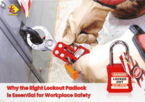


Lockout Tagout procedures are designed to isolate energy sources and ensure that equipment remains inoperable while work is being performed.
In high-risk industrial environments, safety isn’t just a priority – it’s a non-negotiable. Among the many tools that safeguard workers, the lockout padlock plays a pivotal role in preventing accidental energization of machinery during maintenance or repair. But not all padlocks are created equal. Choosing the right lockout padlock can mean the difference between a secure worksite and a catastrophic incident.
The Role of Lockout Padlocks in LOTO Protocols:
Lockout Tagout procedures are designed to isolate energy sources and ensure that equipment remains inoperable while work is being performed. Padlocks are the physical barrier that enforces this isolation. When properly selected and deployed, they:
In short, padlocks are the frontline defense against accidental start-ups – and they must be as reliable as the protocols they support.
What Makes a Padlock “Right” for the Job?
The ideal lockout padlock isn’t just any lock pulled off the shelf. It’s purpose-built for safety applications and tailored to the specific needs of your facility. Key features to consider include:
Choosing padlocks that meet these criteria ensures that your Lockout Tagout system is not only compliant but also intuitive and foolproof.
Safety, Accountability, and Culture:
Beyond compliance, the right padlock fosters a culture of safety. When workers trust that their lockout devices are secure and personalized, they’re more likely to follow procedures diligently. It also reinforces a sense of ownership – each padlock becomes a symbol of responsibility.
Moreover, standardized padlock systems reduce confusion and streamline audits. Safety managers can quickly verify lock status, trace ownership, and ensure that no step is skipped during shutdowns or servicing.
Global Standards, Local Solutions:
In multinational operations, padlock selection must also consider regional regulations and language requirements. Bilingual labeling, universal color codes, and compatibility with global lockout devices help bridge compliance gaps across borders.
Final Thoughts:
The right lockout padlock isn’t just a tool – it’s a statement. It says your organization values safety, respects its workforce, and refuses to compromise on protection. Investing in high-quality, purpose-built padlocks is a small cost with immeasurable returns: fewer accidents, stronger compliance, and a safer, more empowered workplace.
Whether you’re upgrading your LOTO system or training new staff, start with the basics – and make sure your padlocks are up to the task.
